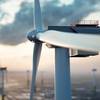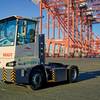Saldanha Bay Could be S.Africa's First LNG Import Terminal
Gas seen as key to help resolve power crisis; gas could be sourced from Nigeria, Angola, Mozambique.
South Africa could build its first 20 billion rand ($1.4 billion) liquefied natural gas (LNG) import facility at the west coast port of Saldanha Bay to feed gas-to-power projects aimed at easing chronic supply shortages, an official said on Tuesday.
Importing LNG is among the options Africa's most developed economy is considering to diversify its energy sources away from coal and ease power shortfalls that have curbed growth.
Several companies, including Shell, Mitsubishi and Sasol, are expected to bid for 3,126 megawatt (MW) gas-to-power projects in the first quarter of 2016, when exact details will become known.
"Saldanha Bay ticks all the boxes," Fernel Abrahams, project manager for the LNG project at the Western Cape provincial government told Reuters.
"It makes economic sense, it will help improve energy security and all our studies around ocean conditions, demurrage and market growth show it is technically feasible to land gas here."
He said the plan would be to build an import facility at, or close to Saldanha Bay, South Africa's deepest natural port and emerging oil and gas hub, with pipelines supplying enough gas for power plants to supply thousands of industrial users and homes stretching to Cape Town around 150 km (90 miles) away.
Richards Bay in KwaZulu-Natal province and Coega in Eastern Cape province have also been mooted as possible sites for an LNG import terminal. The Department of Energy is expected to decide on the terminal and its location next year.
Abrahams said Angola and Nigeria were among likely source markets for the LNG. The country is close to new oil and gas strikes offshore of Mozambique and Tanzania, as well as existing fields from Africa's top two oil producers Nigeria and Angola.
Faster to install compared with nuclear or coal-fired power plants, the proposed terminal will allow the authorities to take advantage of favourable global LNG prices. South Africa plans to add 9,600 MW of nuclear power in the next decade and a half, estimated by analysts to cost as much as $100 billion.
For the gas-to-power projects, the government has said it is looking at power barges - floating power plants installed on a barge - and gas-fired power plants, although details have not yet been finalised.
Abrahams said the proposed LNG project would also supply gas to state-owned power utility Eskom's Ankerlig 1,327 MW diesel-fired open cycle gas turbine (OCGT) power station at Atlantis, also on the west coast.
Eskom wants to convert Ankerlig and its sister OCGT plant, Gourikwa, to use gas, in order to cut its operating costs.
"We like the idea," Eskom's acting Chief Executive Officer Brian Molefe told Reuters, adding that Eskom and national oil company PetroSA are hoping to convert Ankerlig and Gourikwa to use gas within the next 18 months at a cost of 1.8 billion rand.
Luke Havemann, an oil and gas lawyer at ENSafrica, said it was unclear if South Africa would first pipe gas overland from Mozambique or import LNG rather than exploit its own domestic shale gas resources.
"Ideally we want to know if we have domestic gas resources that we can monetize," he said.
The U.S. Energy Information Administration estimates South Africa has the world's eighth-biggest shale reserves, but no exploration licences have yet been granted.
By Wendell Roelf













